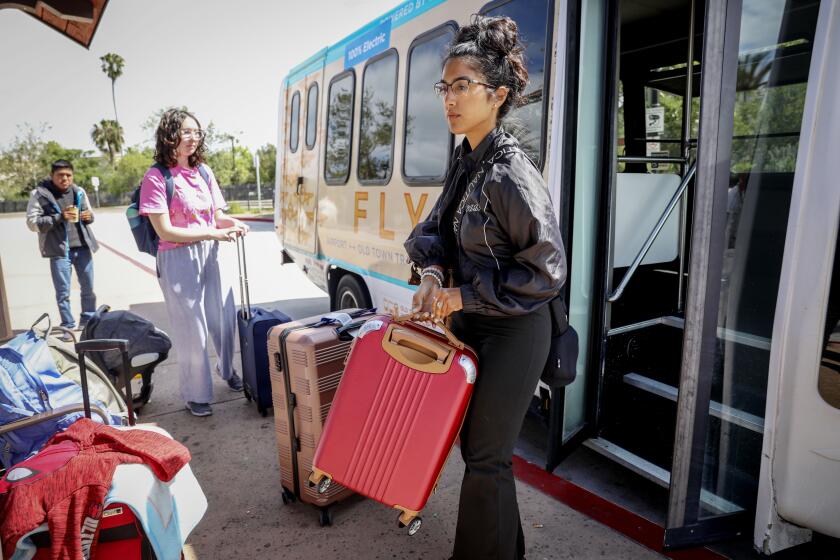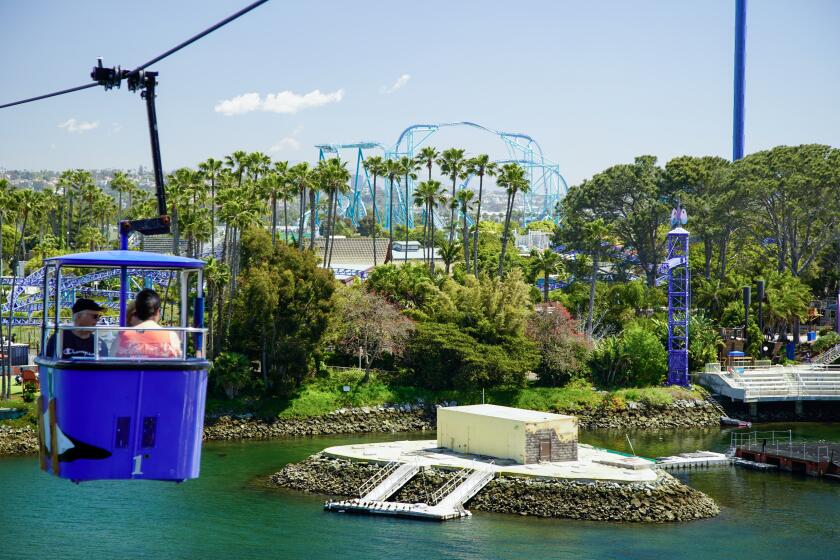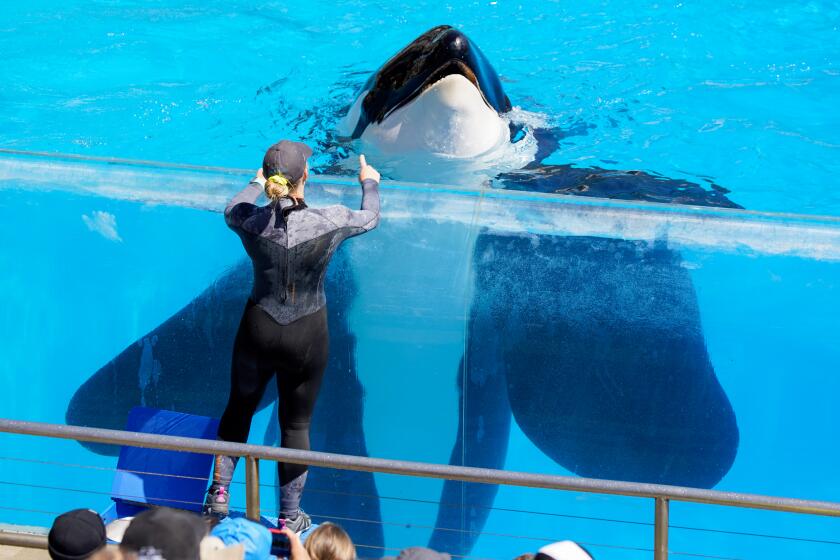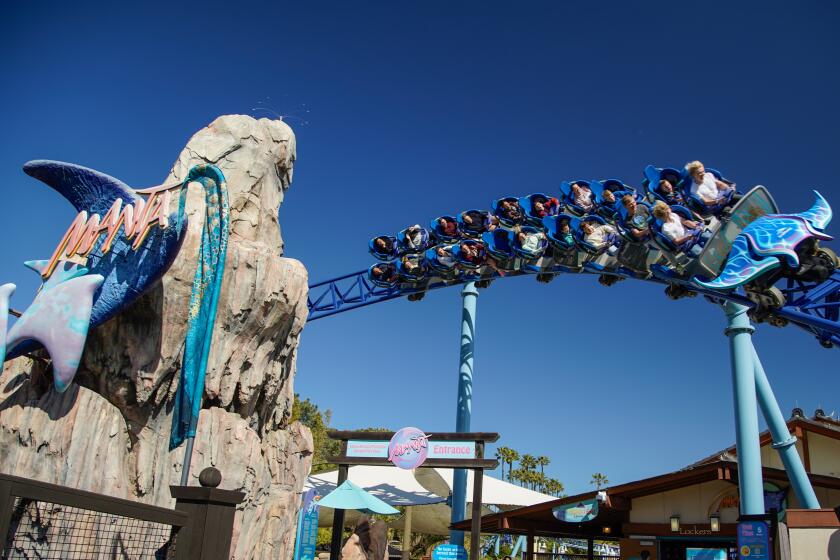One of SeaWorld’s oldest killer whales dies

SeaWorld’s second oldest whale dies following treatment of bacterial respiratory infection
Kasatka, a nearly 42-year-old killer whale that SeaWorld calls the matriarch of its orca family, died Tuesday night, marking the second orca death in a month at its marine parks and the third so far this year.
The whale’s passing followed a years-long treatment for lung disease. In recent days, Kasatka’s health and appetite had declined significantly despite specialized treatments, prompting veterinarians to make the decision to euthanize her to “prevent compromising her quality of life,” SeaWorld said Wednesday.
A mother of four, grandmother of six and great grandmother of two, Kasatka passed away at approximately 8:15 p.m. Tuesday surrounded by members of her pod, as well as the veterinarians and caretakers, park officials said.
One of the last killer whales to come to SeaWorld from the wild, Kasatka was captured near Iceland in 1978 and arrived at the San Diego park that same year.
“Today, I lost a member of my family. I have spent the past several years with Kasatka and was truly blessed to be part of her life,” said Kristi Burtis, orca behaviorist. “Although I am heartbroken, I am grateful for the special time we had together and for the difference she has made for wild orcas by all that we have learned from her. I adored Kasatka and loved sharing her with millions of people. I will miss her very much.”
RELATED
SeaWorld attendance continues to drop
Will new killer whale encounter resurrect SeaWorld?
SeaWorld bids farewell to Shamu show
Kasatka is believed to be the second oldest of all the whales in the SeaWorld marine parks. The oldest is Corky, who is believed to be 53.
Just last month, Kyara, a 3-month-old killer whale born at SeaWorld San Antonio, died after suffering from pneumonia. The exact cause of death has yet to be released by SeaWorld. The calf was the final orca born in captivity at a SeaWorld park. Orlando-based SeaWorld Entertainment announced early last year that it would immediately stop breeding orcas following years of animal rights protests and declining attendance.
Earlier this year, one of SeaWorld’s most widely known whales, Tilikum, estimated to be 36, died at the Orlando park. Responsible for the 2010 drowning death of Orlando trainer Dawn Brancheau, Tilikum was also the centerpiece of the 2013 “Blackfish” documentary, which was critical of SeaWorld’s treatment of its killer whales.
The series of deaths come at an especially difficult time for SeaWorld Entertainment, which has been struggling to revive its brand following years of slumping revenues and faltering attendance.
Last week, the company posted its second quarter earnings, acknowledging in a call with analysts that “public perception issues” about the marine parks have resurfaced and contributed to an attendance decline in San Diego. CEO Joel Manby conceded it was a mistake to have pulled back on heavy marketing showcasing SeaWorld and said the company was re-starting its advertising campaign.
In its blog post announcing Kasatka’s death, SeaWorld said the type of bacterial respiratory condition that the whale was suffering from is considered the most common cause of mortality and illness in whales and dolphins, both in the wild and in zoological facilities.
Naomi Rose, a marine mammal scientist with the Animal Welfare Institute, quickly took issue with that claim, noting that scientists do not know what contributes specifically to orca deaths in the wild, nor does SeaWorld.
“We know that it is very common for orcas in captivity to die of respiratory infections, but in the wild, we don’t know that pneumonia is a common cause of death, so for SeaWorld to say that it’s equally common in both habitats, it’s a false statement,” Rose said.
People for the Ethical Treatment of Animals, which has been a longtime foe of SeaWorld’s and has called for the parks to release their captive orcas to seaside pens, unleashed more criticism on Wednesday.
“The dead bodies at SeaWorld are stacking up about as fast as its stock is falling, with Kasatka dead just a few weeks after the death of her 3-month-old granddaughter,” said PETA Executive Vice President Tracy Reiman. “SeaWorld talks of ‘love’ for her and her family, yet it made a business out of tearing her away from her family as well as ripping apart other bonded orcas and shipping them across the country, even separating Kasatka from her podmate in 1984.”
SeaWorld said Wednesday that its veterinary team will conduct a necropsy to examine the extent of Kasatka’s illness and what impact it had on her organ function.It will likely be several weeks before results are known.
Across SeaWorld’s U.S. parks, there are 21 killer whales, almost all born in captivity. SeaWorld San Diego now has 10 orcas. The Mission Bay park has phased out its theatrical Shamu show and debuted this summer Orca Encounter, designed as a more educational presentation against the backdrop of documentary-style video of orcas in the wild.
Similar presentations will eventually be developed for the Orlando and San Antonio parks.
Business
lori.weisberg@sduniontribune.com
(619) 293-2251
Twitter: @loriweisberg
Get U-T Business in your inbox on Mondays
Get ready for your week with the week’s top business stories from San Diego and California, in your inbox Monday mornings.
You may occasionally receive promotional content from the San Diego Union-Tribune.












